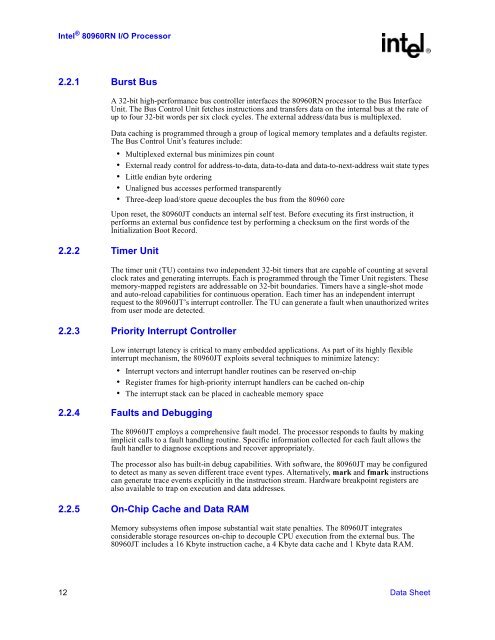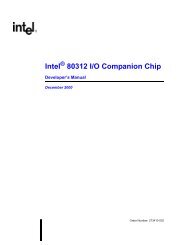IntelR 80960 RN I/O Processor Datasheet
IntelR 80960 RN I/O Processor Datasheet
IntelR 80960 RN I/O Processor Datasheet
Create successful ePaper yourself
Turn your PDF publications into a flip-book with our unique Google optimized e-Paper software.
Intel ® <strong>80960</strong><strong>RN</strong> I/O <strong>Processor</strong><br />
2.2.1 Burst Bus<br />
2.2.2 Timer Unit<br />
A 32-bit high-performance bus controller interfaces the <strong>80960</strong><strong>RN</strong> processor to the Bus Interface<br />
Unit. The Bus Control Unit fetches instructions and transfers data on the internal bus at the rate of<br />
up to four 32-bit words per six clock cycles. The external address/data bus is multiplexed.<br />
Data caching is programmed through a group of logical memory templates and a defaults register.<br />
The Bus Control Unit’s features include:<br />
• Multiplexed external bus minimizes pin count<br />
• External ready control for address-to-data, data-to-data and data-to-next-address wait state types<br />
• Little endian byte ordering<br />
• Unaligned bus accesses performed transparently<br />
• Three-deep load/store queue decouples the bus from the <strong>80960</strong> core<br />
Upon reset, the <strong>80960</strong>JT conducts an internal self test. Before executing its first instruction, it<br />
performs an external bus confidence test by performing a checksum on the first words of the<br />
Initialization Boot Record.<br />
The timer unit (TU) contains two independent 32-bit timers that are capable of counting at several<br />
clock rates and generating interrupts. Each is programmed through the Timer Unit registers. These<br />
memory-mapped registers are addressable on 32-bit boundaries. Timers have a single-shot mode<br />
and auto-reload capabilities for continuous operation. Each timer has an independent interrupt<br />
request to the <strong>80960</strong>JT’s interrupt controller. The TU can generate a fault when unauthorized writes<br />
from user mode are detected.<br />
2.2.3 Priority Interrupt Controller<br />
Low interrupt latency is critical to many embedded applications. As part of its highly flexible<br />
interrupt mechanism, the <strong>80960</strong>JT exploits several techniques to minimize latency:<br />
• Interrupt vectors and interrupt handler routines can be reserved on-chip<br />
• Register frames for high-priority interrupt handlers can be cached on-chip<br />
• The interrupt stack can be placed in cacheable memory space<br />
2.2.4 Faults and Debugging<br />
The <strong>80960</strong>JT employs a comprehensive fault model. The processor responds to faults by making<br />
implicit calls to a fault handling routine. Specific information collected for each fault allows the<br />
fault handler to diagnose exceptions and recover appropriately.<br />
The processor also has built-in debug capabilities. With software, the <strong>80960</strong>JT may be configured<br />
to detect as many as seven different trace event types. Alternatively, mark and fmark instructions<br />
can generate trace events explicitly in the instruction stream. Hardware breakpoint registers are<br />
also available to trap on execution and data addresses.<br />
2.2.5 On-Chip Cache and Data RAM<br />
Memory subsystems often impose substantial wait state penalties. The <strong>80960</strong>JT integrates<br />
considerable storage resources on-chip to decouple CPU execution from the external bus. The<br />
<strong>80960</strong>JT includes a 16 Kbyte instruction cache, a 4 Kbyte data cache and 1 Kbyte data RAM.<br />
12 Data Sheet

















